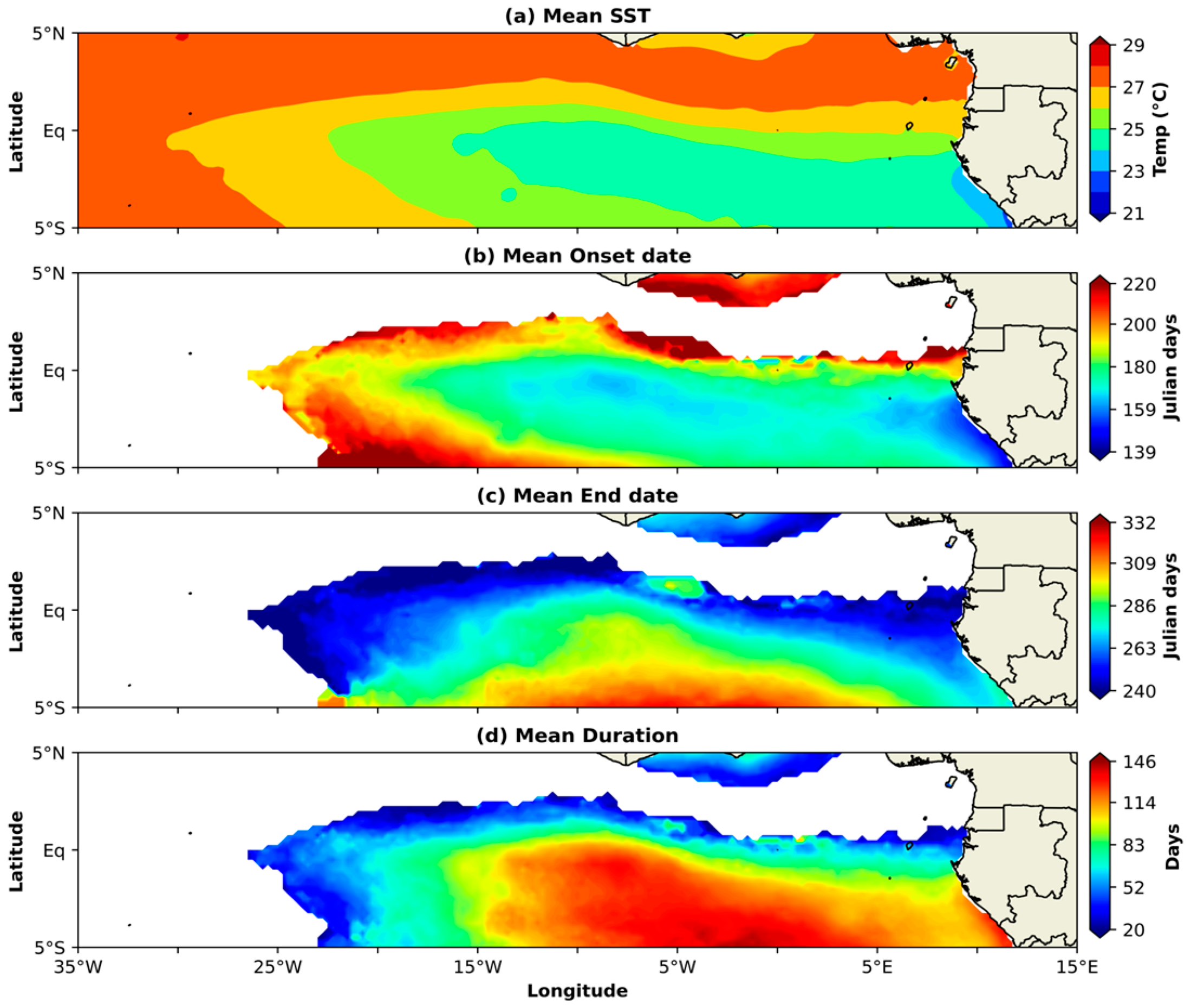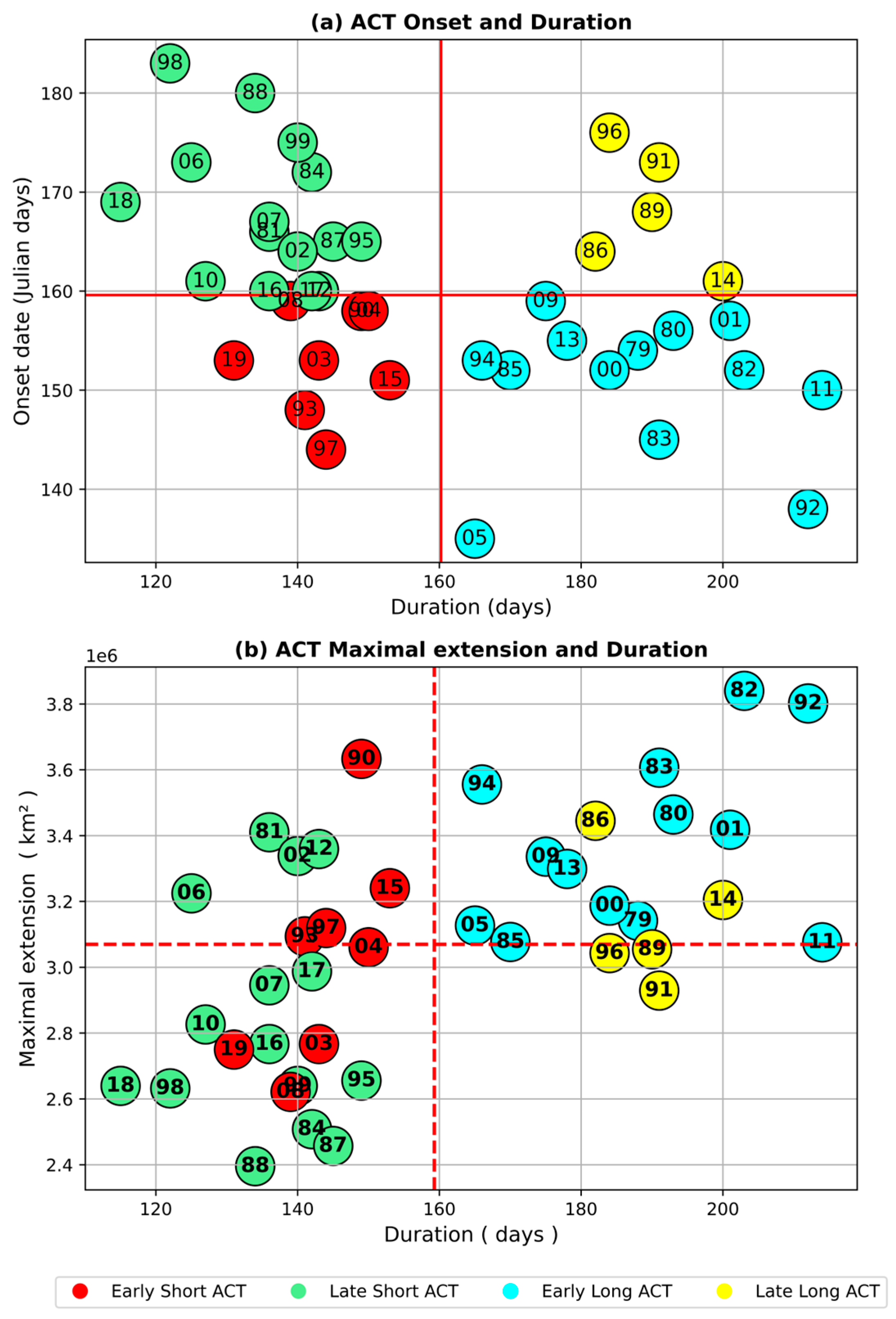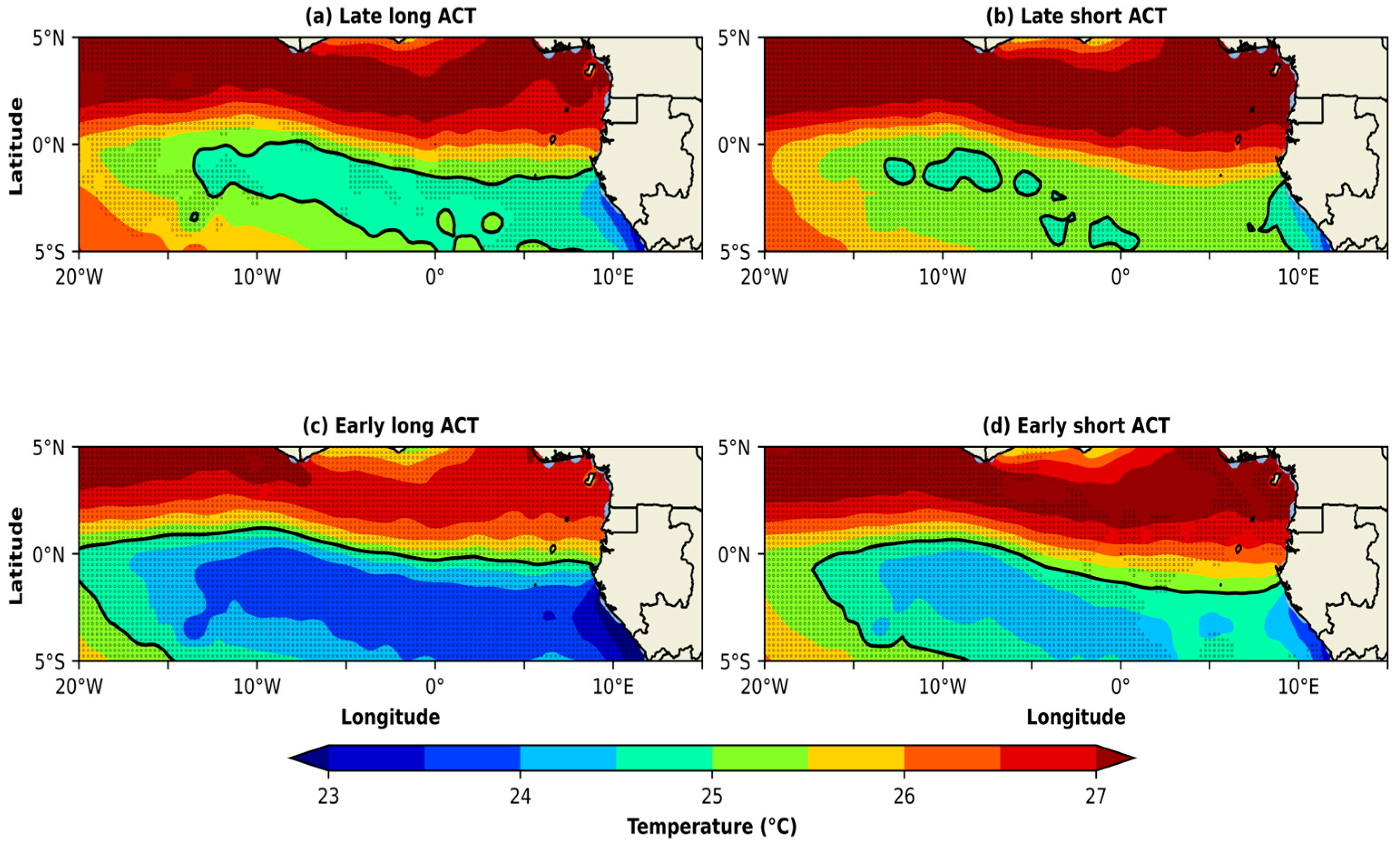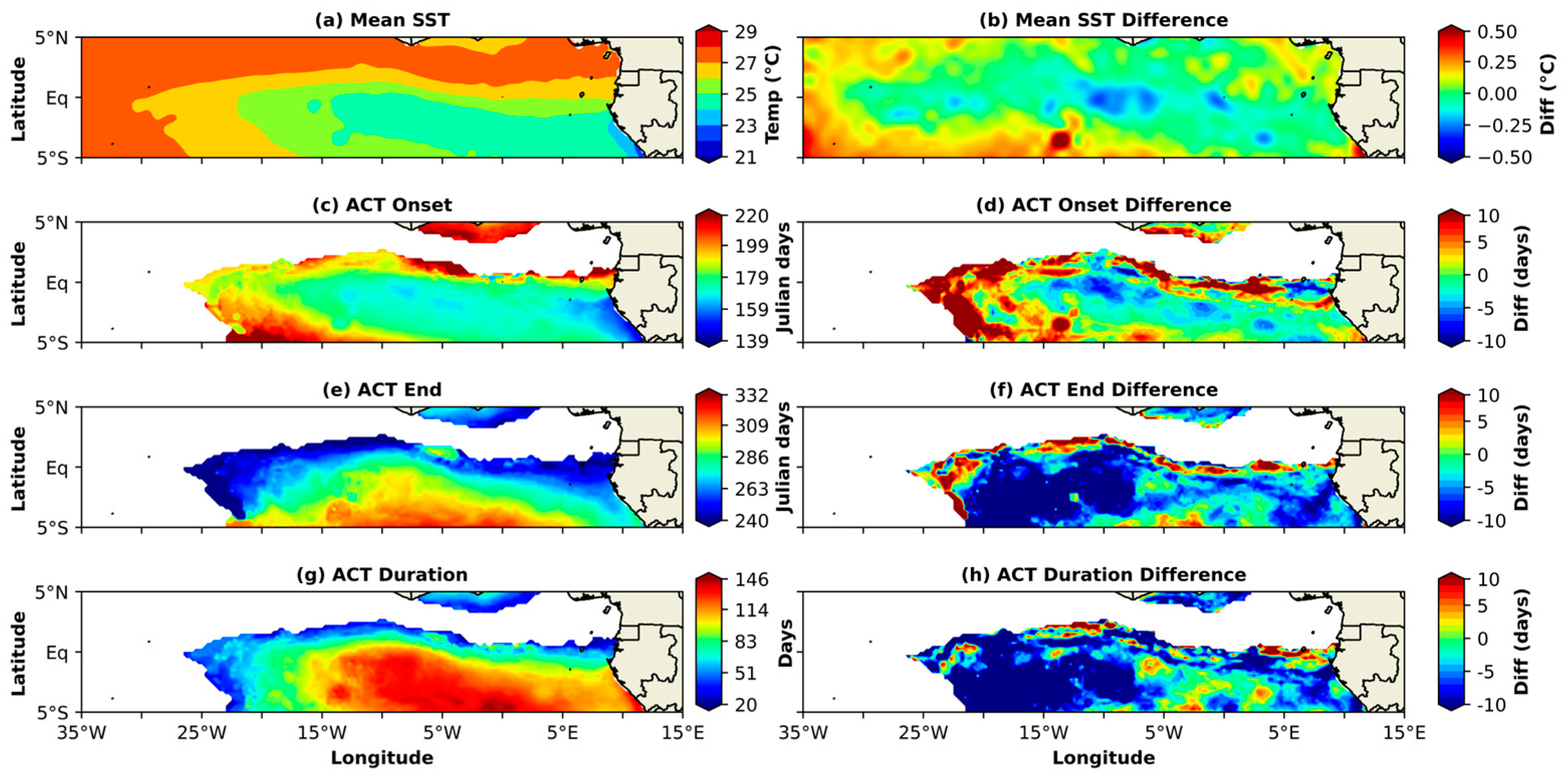Composite Study of Relationships Between the Characteristics of Atlantic Cold Tongue: Onset, Duration, and Maximum Extent
Abstract
1. Introduction
2. Data and Methodology
3. Results and Discussion
3.1. Mean Seasonal Cycle of the Atlantic Cold Tongue
3.2. Mean Characteristics of the Atlantic Cold Tongue
- Date of the ACT onset: 7th June ± 11 days;
- Date of the ACT end: 13th November ± 26 days;
- Duration of ACT (days): 160 ± 28 days;
- Largest area covered by the ACT (105 km2): 30.7 ± 3.7;
- Date of the largest area covered by the ACT: 10th August ± 13 days.
3.3. Relationships Between Mean Characteristics of the Atlantic Cold Tongue
3.4. Composite Study of Observed Changes in ACT Characteristics
4. Conclusions
Author Contributions
Funding
Institutional Review Board Statement
Informed Consent Statement
Data Availability Statement
Acknowledgments
Conflicts of Interest
References
- Sultan, B.; Janicot, S.; Diedhiou, A. The West African Monsoon Dynamics. Part I: Documentation of Intraseasonal Variability. J. Clim. 2003, 16, 3389–3406. [Google Scholar] [CrossRef]
- Steinig, S.; Harlaß, J.; Park, W.; Latif, M. Sahel rainfall strength and onset improvements due to more realistic Atlantic cold tongue development in a climate model. Sci. Rep. 2018, 8, 2569. [Google Scholar] [CrossRef]
- Caniaux, G.; Giordani, H.; Redelsperger, J.-L.; Guichard, F.; Key, E.; Wade, M. Coupling between the Atlantic cold tongue and the West African monsoon in boreal spring and summer. J. Geophys. Res. 2011, 116, C04003. [Google Scholar] [CrossRef]
- Nobre, P.; Srukla, J. Variations of Sea Surface Temperature, Wind Stress, and Rainfall over the Tropical Atlantic and South America. J. Clim. 1996, 9, 2464–2479. [Google Scholar] [CrossRef]
- Philander, S.G.H.; Pacanowski, R.C. The mass and heat budget in a model of the tropical Atlantic Ocean. J. Geophys. Res. Ocean. 1986, 91, 14212–14220. [Google Scholar] [CrossRef]
- Planton, Y.; Voldoire, A.; Giordani, H.; Caniaux, G. Main processes of the Atlantic cold tongue interannual variability. Clim. Dyn. 2018, 50, 1495–1512. [Google Scholar] [CrossRef]
- Wang, C.; Enfield, D.B. The Tropical Western Hemisphere Warm Pool. Geophys. Res. Lett. 2001, 28, 1635–1638. [Google Scholar] [CrossRef]
- Bjerknes, J. Atlantic Air-Sea Interaction. In Advances in Geophysics; Elsevier: Amsterdam, The Netherlands, 1964; pp. 1–82. [Google Scholar]
- Prodhomme, C.; Voldoire, A.; Exarchou, E.; Deppenmeier, A.L.; García-Serrano, J.; Guemas, V. How Does the Seasonal Cycle Control Equatorial Atlantic Interannual Variability? Geophys. Res. Lett. 2019, 46, 916–922. [Google Scholar] [CrossRef]
- Keenlyside, N.S.; Latif, M. Understanding Equatorial Atlantic Interannual Variability. J. Clim. 2007, 20, 131–142. [Google Scholar] [CrossRef]
- Brandt, P.; Schott, F.A.; Provost, C.; Kartavtseff, A.; Hormann, V.; Bourlès, B.; Fischer, J. Circulation in the central equatorial Atlantic: Mean and intraseasonal to seasonal variability. Geophys. Res. Lett. 2006, 33, 2005GL025498. [Google Scholar] [CrossRef]
- Carton, J.A.; Chepurin, G.; Cao, X.; Giese, B. A Simple Ocean Data Assimilation Analysis of the Global Upper Ocean 1950–95. Part I: Methodology. J. Phys. Oceanogr. 2000, 30, 294–309. [Google Scholar] [CrossRef]
- Jouanno, J.; Marin, F.; Du Penhoat, Y.; Sheinbaum, J.; Molines, J.M. Seasonal heat balance in the upper 100 m of the equatorial Atlantic Ocean. J. Geophys. Res. 2011, 116, C09003. [Google Scholar] [CrossRef]
- Flaounas, E.; Bastin, S.; Janicot, S. Regional climate modelling of the 2006 West African monsoon: Sensitivity to convection and planetary boundary layer parameterisation using WRF. Clim. Dyn. 2011, 36, 1083–1105. [Google Scholar] [CrossRef]
- Nguyen, H.; Thorncroft, C.D.; Zhang, C. Guinean coastal rainfall of the West African Monsoon. Q. J. R. Meteorol. Soc. 2011, 137, 1828–1840. [Google Scholar] [CrossRef]
- Janicot, S.; Thorncroft, C.D.; Ali, A.; Asencio, N.; Berry, G.; Bock, O.; Bourles, B.; Caniaux, G.; Chauvin, F.; Deme, A.; et al. Large-scale overview of the summer monsoon over West Africa during the AMMA field experiment in 2006. Ann. Geophys. 2008, 26, 2569–2595. [Google Scholar] [CrossRef]
- Druyan, L.M.; Fulakeza, M. The impact of the Atlantic cold tongue on West African monsoon onset in regional model simulations for 1998–2002. Int. J. Climatol. 2015, 35, 275–287. [Google Scholar] [CrossRef]
- Obada, E.; Alamou, E.A.; Biao, E.I.; Zandagba, E.B.J. Interannual Variability and Trends of Extreme Rainfall Indices over Benin. Climate 2021, 9, 160. [Google Scholar] [CrossRef]
- Hersbach, H.; Bell, B.; Berrisford, P.; Hirahara, S.; Horányi, A.; Muñoz-Sabater, J.; Nicolas, J.; Peubey, C.; Radu, R.; Schepers, D.; et al. The ERA5 global reanalysis. Q. J. R. Meteorol. Soc. 2020, 146, 1999–2049. [Google Scholar] [CrossRef]
- Brandt, P.; Caniaux, G.; Bourlès, B.; Lazar, A.; Dengler, M.; Funk, A.; Hormann, V.; Giordani, H.; Marin, F. Equatorial upper-ocean dynamics and their interaction with the West African monsoon. Atmos. Sci. Lett. 2011, 12, 24–30. [Google Scholar] [CrossRef]
- Reynolds, R.W.; Smith, T.M.; Liu, C.; Chelton, D.B.; Casey, K.S.; Schlax, M.G. Daily High-Resolution-Blended Analyses for Sea Surface Temperature. J. Clim. 2007, 20, 5473–5496. [Google Scholar] [CrossRef]
- Zebiak, S.E. Air–Sea Interaction in the Equatorial Atlantic Region. J. Clim. 1993, 6, 1567–1586. [Google Scholar] [CrossRef]
- Xie, S.P.; Annamalai, H.; Schott, F.A.; McCreary, J.P. Structure and Mechanisms of South Indian Ocean Climate Variability*. J. Clim. 2002, 15, 864–878. [Google Scholar] [CrossRef]
- Xie, S.-P.; Carton, J.A. Tropical Atlantic Variability: Patterns, Mechanisms, and Impacts. In Geophysical Monograph Series; Wang, C., Xie, S.P., Carton, J.A., Eds.; American Geophysical Union: Washington, DC, USA, 2004; pp. 121–142. [Google Scholar]
- Richter, I.; Behera, S.K.; Masumoto, Y.; Taguchi, B.; Sasaki, H.; Yamagata, T. Multiple causes of interannual sea surface temperature variability in the equatorial Atlantic Ocean. Nat. Geosci. 2013, 6, 43–47. [Google Scholar] [CrossRef]
- Servain, J.; Wainer, I.; McCreary, J.P.; Dessier, A. Relationship between the equatorial and meridional modes of climatic variability in the tropical Atlantic. Geophys. Res. Lett. 1999, 26, 485–488. [Google Scholar] [CrossRef]
- Zebiak, S.E.; Cane, M.A. A Model El Niñ–Southern Oscillation. Mon. Weather. Rev. 1987, 115, 2262–2278. [Google Scholar]
- Barton, E.D. Eastern boundary of the North Atlantic: Northwest Africa and Iberia. In The Sea; John Wiley & Sons Inc.: New York, NY, USA, 1998; pp. 633–657. [Google Scholar]
- Meynadier, R.; de Coëtlogon, G.; Leduc-Leballeur, M.; Eymard, L.; Janicot, S. Seasonal influence of the sea surface temperature on the low atmospheric circulation and precipitation in the eastern equatorial Atlantic. Clim. Dyn. 2016, 47, 1127–1142. [Google Scholar] [CrossRef]
- McPhaden, M.J.; Zhang, D. Slowdown of the meridional overturning circulation in the upper Pacific Ocean. Nature 2002, 415, 603–608. [Google Scholar] [CrossRef]
- Lübbecke, J.F.; McPhaden, M.J. On the Inconsistent Relationship between Pacific and Atlantic Niños*. J. Clim. 2012, 25, 4294–4303. [Google Scholar] [CrossRef]
- Diakhaté, M.; Rodríguez-Fonseca, B.; Gómara, I.; Mohino, E.; Dieng, A.L.; Gaye, A.T. Oceanic Forcing on Interannual Variability of Sahel Heavy and Moderate Daily Rainfall. J. Hydrometeorol. 2019, 20, 397–410. [Google Scholar] [CrossRef]
- Didi, S.R.; Diakhaté, M.; Diedhiou, A. Changes in the West Africa Monsoon Precipitation Extremes during ENSO developing Phases. Atmos. Ocean 2023, 61, 293–305. [Google Scholar] [CrossRef]







| Early-Long ACT | Late-Long ACT | Early-Short ACT | Late-Short ACT |
|---|---|---|---|
| 1982 | 1986 | 1993 | 1988 |
| 1983 | 1989 | 1997 | 1998 |
| 1992 | 1991 | 2003 | 1999 |
| 2011 | 1996 | 2019 | 2006 |
Disclaimer/Publisher’s Note: The statements, opinions and data contained in all publications are solely those of the individual author(s) and contributor(s) and not of MDPI and/or the editor(s). MDPI and/or the editor(s) disclaim responsibility for any injury to people or property resulting from any ideas, methods, instructions or products referred to in the content. |
© 2025 by the authors. Licensee MDPI, Basel, Switzerland. This article is an open access article distributed under the terms and conditions of the Creative Commons Attribution (CC BY) license (https://creativecommons.org/licenses/by/4.0/).
Share and Cite
Koné, D.I.; Diawara, A.; Kouassi, B.K.; Yoroba, F.; Kouadio, K.; Yapo, A.L.M.; Tiemoko, T.D.; Diarrassouba, M.; Silué, F.; Diedhioune, A. Composite Study of Relationships Between the Characteristics of Atlantic Cold Tongue: Onset, Duration, and Maximum Extent. Atmosphere 2025, 16, 47. https://doi.org/10.3390/atmos16010047
Koné DI, Diawara A, Kouassi BK, Yoroba F, Kouadio K, Yapo ALM, Tiemoko TD, Diarrassouba M, Silué F, Diedhioune A. Composite Study of Relationships Between the Characteristics of Atlantic Cold Tongue: Onset, Duration, and Maximum Extent. Atmosphere. 2025; 16(1):47. https://doi.org/10.3390/atmos16010047
Chicago/Turabian StyleKoné, Dianikoura Ibrahim, Adama Diawara, Benjamin Komenan Kouassi, Fidele Yoroba, Kouakou Kouadio, Assi Louis Martial Yapo, Touré Dro Tiemoko, Mamadou Diarrassouba, Foungnigué Silué, and Arona Diedhioune. 2025. "Composite Study of Relationships Between the Characteristics of Atlantic Cold Tongue: Onset, Duration, and Maximum Extent" Atmosphere 16, no. 1: 47. https://doi.org/10.3390/atmos16010047
APA StyleKoné, D. I., Diawara, A., Kouassi, B. K., Yoroba, F., Kouadio, K., Yapo, A. L. M., Tiemoko, T. D., Diarrassouba, M., Silué, F., & Diedhioune, A. (2025). Composite Study of Relationships Between the Characteristics of Atlantic Cold Tongue: Onset, Duration, and Maximum Extent. Atmosphere, 16(1), 47. https://doi.org/10.3390/atmos16010047







